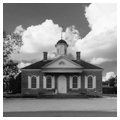Ironically, eighteenth-century Williamsburg's most academic pediment lacks any apparent structural support. All but one nineteenth-century illustration show the porch unsupported, and in 1796 Benjamin Henry Latrobe commented on the absence of columns carrying the cantilevered structure. The pediment, an octagonal cupola, and round-headed windows emphasized the public function of the Williamsburg and James City Courthouse, built in 1771 to replace less generous quarters the Williamsburg court had occupied in the old Palace Street theater building since 1745 and in the James City County Courthouse at England and Francis streets. The porch also sheltered participants and onlookers on court days, as arcaded loggias did elsewhere in the colony. Inside the front door was sizable standing space for the public, flanked by a jury room, justices' chamber, and clerks' offices. Beyond, in the large central room, was an arrangement of sitting and standing spaces that embodied the Virginia leadership's sense of hierarchy, from the chief justice's cushioned ceremonial chair to the place where the accused stood beside the clerk's table. The interior, remodeled late in the nineteenth century, was lost in a 1911 fire, and the building has been restored three times, first to save and reuse the old walls and last to recreate the eighteenth-century fittings and their uses.
You are here
Courthouse
If SAH Archipedia has been useful to you, please consider supporting it.
SAH Archipedia tells the story of the United States through its buildings, landscapes, and cities. This freely available resource empowers the public with authoritative knowledge that deepens their understanding and appreciation of the built environment. But the Society of Architectural Historians, which created SAH Archipedia with University of Virginia Press, needs your support to maintain the high-caliber research, writing, photography, cartography, editing, design, and programming that make SAH Archipedia a trusted online resource available to all who value the history of place, heritage tourism, and learning.






